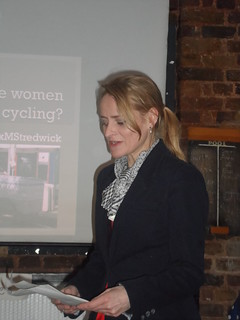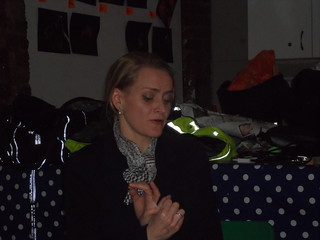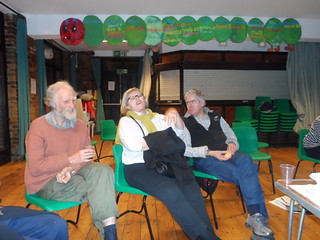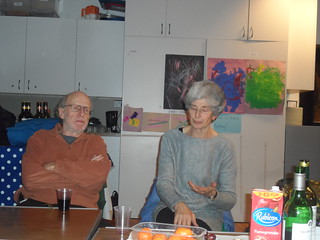 Alix drew from a long and wide involvement in cycling initiatives that had begun with work on promoting rail travel in 1999, through to Travel Planner for Sustrans in Hackney, managing the Cycling for Women project (2003 to 2004) for the Women’s Design Service (WDS) in Camden and Lambeth and writing several research papers. During her time as an advocate at Women & Cycling, she first came into contact with Jean Dollimore and others in LCC.
Alix drew from a long and wide involvement in cycling initiatives that had begun with work on promoting rail travel in 1999, through to Travel Planner for Sustrans in Hackney, managing the Cycling for Women project (2003 to 2004) for the Women’s Design Service (WDS) in Camden and Lambeth and writing several research papers. During her time as an advocate at Women & Cycling, she first came into contact with Jean Dollimore and others in LCC.
Referring to a recent paper by Rachel Aldred, James Woodcock & Anna Goodman (Feb 27), with some interesting new evidence – including some showing an absence of any increase in numbers of women cycling in the UK – and furthermore an actual drop in numbers, Alix considered the question of why women & cycling is important as an issue.
Women are, we were told, more inclined to cycle than men, despite prevalence of all too familiar deterrents. With numbers of people cycling to work in the UK having been stuck at 3% for several years – and considering that large organisations such as the NHS employ such huge numbers of women (3/4 of its staff) are amongst the declining figures, there is a great potential here for getting more women cycling not only to, but also in the course of, work (with household visits by midwives being an example of where improvements could be made).
Statistics published by the DfT in 2007 were presented showing women’s share of cycling in several European countries and the US –
US UK Canada Germany Denmark Netherlands
25% 27% 30% 49% 55% 56%
It was mentioned that with cycling becoming more popular in The Netherlands and Germany, there has been an increases in certain medical problems such as those involving hips and other similar ailments amongst the Dutch.
The concerns of an ageing population was referred to as part of a more general need for an Equality Of Mobility and, after considering why there is such inequality amongst different user groups in cycling, Alix referred to the following factors-
•Trip Characteristics (types of journeys usually made by bike)
•Cultural norms (the need for people to feel part of an ‘in-group’)
•Infrastructure – the lack of provision of safe, joined-up and appealing networks that encourage riding along with other measures all to familiar to cycling campaigners)
Alix talked about escort trips and journey-chaining – and also about how carrying ‘things’ or children – was not felt as viable by bike. During her consultation experience at Cycle Enfield – the concerns about the possibility of ‘going shopping’ and ‘carrying shopping’ were all to o frequently questioned by traders and others. The percentage of Enfield residents currently cycling was given as 0.7%.
o frequently questioned by traders and others. The percentage of Enfield residents currently cycling was given as 0.7%.
Elsewhere, her experience of working on Cycling to School projects in Hackney showed that care-givers have a big influence on how children view travelling, with mums in particular having a large say in family travel decision-making. Cycle training initiatives were considered to be greatly beneficial for increasing confidence with cycling amongst traffic and that this in turn was important for their children’s confidence.
The Cycling for Women project (CfW) run by Women’s Design Service in Camden and Lambeth was funded by SEED Programme (part of the national lottery) and TfL, with support from Lambeth and Camden councils, LCC, Evans cycles, Bikefix, Brixton Cycles and also Transport 2000 and Sustrans.
For this project (CfW), the WDS did outreach and recruitment which included a scheme whereby postcards were left in bike shops, at various events, libraries, health food shops and community centres, for women to write about their cycling experience before returning them by post – one lady wrote “I’ve been cycling in London for years and no-one’s ever asked me how I felt about it”.
On the issue of health and cycling, this was felt to be somewhat under-reported in English speaking countries whilst no exact correlation has so far been made between obesity & cycling.
The reasons provided for preventing women cycling were familiar to campaigners, with fear of traffic naturally being the main reason given by some 30% of UK cyclists (safety fears). Cycling For Women Projects have found same reasons.
Despite this exidence, the percentages of all KSIs have been found to be pretty much equal (though James Brander – who carried out a STATS 19 record-analysis for Camden – pointed out that ‘the KSIs are proportionately higher given that only a quarter of cyclists are women’).
Perceived safety then, is considered to be very important in encouraging women to cycle –
the role of engineering is more important than that of statistics. Fear continues to prevent people being exposed to this activity.
Alix talked about other events & activities to help get more women cycling – referring to the significance of the cultural norm. British Cycling’s initiative Breeze – who lead women only rides – was mentioned, and the need for there to be greater general visibility for women’s cycling particularly with younger women and girls of secondary school age. Within this group, the association with ‘sports’ is considered to have a ‘deterrent effect’. In Exeter, the Bicycle Belles project, which aims at increasing cycling for secondary school girls – found that many drop out of the scheme at age 13.
Similar projects have been run in conjunction with CTC (The Champions project) which encouraged – women and girls in cities such as Bradford, through an association with the Duke Of Edinburgh Award scheme. Mostly muslim girls, who had usually had a very protective upbringing, attended these schemes which covered the options of cycle training, walking or gardening. The cycle training option was overwhelmingly taken up by women.
Alix made mention of Sam Margolis (LB Greenwich) and the effectiveness of cycle training – (which is the title of a lecture he is giving as part of the next P TRC Cycling lecture series) and the importance of infrastructure – of keeping cars on main streets and ensuring their restraint – making car journeys circuitous and with less freedom for car-parking – separate cycle tracks on main roads are essential along with the reduction of conflict at junctions and of course speed reduction for motor vehicles. Amsterdam was referred to with their problem with bike parking! – i.e. there’s not enough of it! However, the Dutch continue to improve on this issue.
TRC Cycling lecture series) and the importance of infrastructure – of keeping cars on main streets and ensuring their restraint – making car journeys circuitous and with less freedom for car-parking – separate cycle tracks on main roads are essential along with the reduction of conflict at junctions and of course speed reduction for motor vehicles. Amsterdam was referred to with their problem with bike parking! – i.e. there’s not enough of it! However, the Dutch continue to improve on this issue.
Summing up and with reference to the cargo bike company she runs, Alix quoted David Hembrow – “city centre streets are perfect for children on their own bicycle – if a city centre is truly planned for cycling, cargo bikes shouldn’t be required”.
The talk finished with some bicycledutch Youtube extracts that illustrated and served to remind us what we are striving to achieve.
Alix’s conclusion was taken from her TPS bursary paper –
“places that have embraced cycling take it seriously and provide high quality cycle facilities that anyone who wants to cycle can use “


